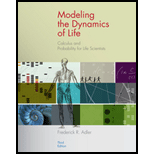
Concept explainers
To calculate: The composition of discrete-time dynamical system of medication concentration
Answer to Problem 8E
The composition of the system with itself is
Explanation of Solution
Given information:
The discrete-time dynamical system of medication concentration
Formula used:
The composition of function f and g is denoted by
Here f is the outer function and g is the inner function. It is also known as f of g at x .
Calculation:
Consider the provided discrete-time dynamical system of medication concentration
Denote the system as
Now, the composition of the system with itself is, recall composition of function f and g is denoted by
Here f is the outer function and g is the inner function. It is also known as f of g at x .
So composition is,
Since,
Now, substitute M as
Therefore, composition of the system with itself is
So, the two step discrete-time dynamical system is,
The initial condition of the system is
Therefore, medication concentration when
Next compute the medication concentrationwhen
Therefore, medication concentration when
Last the length in two step discrete-time dynamical system
It is observed that result of original discrete-time dynamical system applied twice to initial condition matches the result when new discrete-time dynamical system is applied once to initial condition.
Thus, composition of the system with itself is
Want to see more full solutions like this?
Chapter 1 Solutions
Modeling the Dynamics of Life: Calculus and Probability for Life Scientists
 Linear Algebra: A Modern IntroductionAlgebraISBN:9781285463247Author:David PoolePublisher:Cengage LearningAlgebra & Trigonometry with Analytic GeometryAlgebraISBN:9781133382119Author:SwokowskiPublisher:Cengage
Linear Algebra: A Modern IntroductionAlgebraISBN:9781285463247Author:David PoolePublisher:Cengage LearningAlgebra & Trigonometry with Analytic GeometryAlgebraISBN:9781133382119Author:SwokowskiPublisher:Cengage

